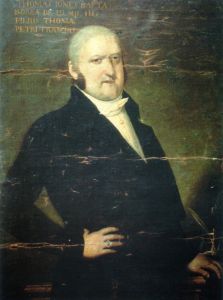Mayor and Patriot
He was born in Sanremo on 8 March 1767 from Tomaso Pietro Francesco and Countess Livia Maria Teresa Pianavia Roverizio in the family palace.  Of anti-Genovese and French feelings, at the age of twenty-seven he had the fortune of meeting personally with Napoleon Bonaparte, then a simple brigadier general in command of artillery and genius of the Italian Army, in the house of Count Sapia Rossi, on 7 September 1794, a few days after the first battle of Dego.
Of anti-Genovese and French feelings, at the age of twenty-seven he had the fortune of meeting personally with Napoleon Bonaparte, then a simple brigadier general in command of artillery and genius of the Italian Army, in the house of Count Sapia Rossi, on 7 September 1794, a few days after the first battle of Dego.
After the fall of the oligarchic Republic and the period of the French occupation, in 1805, at the time of the annexation of Liguria to the Napoleonic Empire, he was elected maire (mayor) and president of the Arrondissement of Sanremo, thus zealously serving the emperor until the fall of the Bonaparte regime. In July of the same year he was also received by Napoleon in Genoa together with some notables from Sanremo, including the lawyer Costanzo Grossi and the municipal agents Gio Batta Sapia Rossi and Luigi Stella.
During his administration, however, he was not only concerned with bureaucratic issues, but also carried out an intense activity aimed at stimulating the local economy, in particular that linked to the production and trade of citrus fruits, which indeed constituted the main income of his income together with the salary of an imperial official.
Because of his political and administrative merits, Napoleon also named him "Baron of the Empire" by letters of license promulgated in the Palace of Saint-Cloud on 3 July 1813, which established that the title was transmissible by order of male primogeniture to direct, legitimate, natural or adoptive descent.
During his mandate he attended, among other things, the laying of the painting of Saint Napoleon in the Sanctuary of the Madonna della Costa on 14th August 1808, blessing the Bishop of Albenga Angelo Vincenzo Dania.
From also note that he belonged to the Masonic Lodge of Nice entitled "Les Vrais Amis Réunis", a meeting place for soldiers, entrepreneurs and Italian and French officials of the time, among whom he knew the chief engineer Teulére, Prince of Rosa Croce, who would be entrusted with the study of the Sanremo port area and the project for the construction of the new pier.
In the last days of his administration, the festive welcome that he and the entire Matuzian municipality gave to Pope Pius VII on his return to Rome from French exile are particularly remembered; he hosted with great honour the Pope in his palace and also had the honour of being received in private audience by the Pope, together with his whole family, on 12 February 1814. After the departure of Pius VII, he made to wall up two inscriptions inside the palace in memory of the pontiff's stay.
After the fall of Napoleon in April 1814, he fought for the return of the Jesuits to Sanremo and openly sided for the annexation of the city to the Kingdom of Sardinia, so much so that he was called upon to be part of a Deputation of six municipal councillors appointed to go to Turin to pay homage to the new Savoy sovereign Vittorio Emanuele I.
From 1815 onwards he held the position of Chief Elder, i.e. President of the City Council, still having to face numerous disasters including an invasion of ferocious wolves in 1815, a serious drought in 1817, and the strong earthquake that struck the city in 1818 damaging various public buildings and many private houses, including a property owned by the Borea d'Olmo family located near Fontanassa.
In 1826, together with the intendant Alberto Nota and the mayor Gismondi, he went to Nice to pay homage to King Carlo Alberto.
Two years later he opposed the construction of the aqueduct wanted by the new mayor Siro Andrea Carli, as the water channelled into the valley of the San Francesco torrent would not have wetted the lemon fields, limiting the operation of the mills for the production of the oil, but his appeal was not accepted.
On 11 April 1836 he offered King Carlo Alberto, passing through the city, his residence, but this time the sovereign declined the invitation because he had already planned a visit to the forts of Ventimiglia.
He died on 10th May 1838 and his body was buried in the cemetery of the Foce near the noble chapel of the Sapia Rossi, now disappeared.
(Source: Vite di Sanremesi Illustri di A.Gandolfo)




